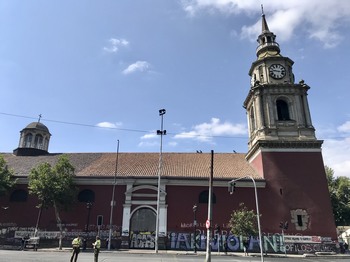San Francisco Church and Convent

San Francisco Church and Convent is part of the Tentative list of Chile in order to qualify for inclusion in the World Heritage List.
San Francisco Church and Convent in Santiago, dating from 1622, are among the oldest colonial buildings in Chile. They were built by the Franciscan order. The cloisters shelter valuable works of art, including 42 paintings of the Cuzco school representing the life of Saint Francis. The building currently houses the Colonial Museum.
Map of San Francisco Church and Convent
Load mapThe coordinates shown for all tentative sites were produced as a community effort. They are not official and may change on inscription.
Community Reviews
Allan & Lucia
The Museo de Colonia de San Francisco is an externally unassuming building right in the heart of downtown Santiago. Its significance lies not in its design (there are no shortage of colonial buildings of its type throughout Latin America) but that it survived at all. It is the oldest building in Santiago, and one of only a handful from the 16th century in Chile to survive several hundred years of earthquakes and social conflict.
The building is the standard Spanish Colonial style, with a central courtyard filled with trees surrounded by white plastered arches supporting a wooden upper deck and terracotta tiles. Despite being in the heart of the city, its surprisingly peaceful. There's almost no traffic noise from the busy Av. Liberador Bernardo O’Higgins outside. If not for the occasional tower block poking out from above the roof, it is sufficiently quiet to forget you were in a city at all.
I arrived early in the day, and for a long time, I was the only person here, strolling peacefully in and out of the gallery rooms. The paintings, like the building, are in desperate need of restoration, stained and faded from decades of pollution. The paintings are striking, but much of it lacks context, and there's nothing to help a visitor gain a further understanding of the significance of the works. The building suffers as well. Peeling plasterwork, cracks in the walls, and decaying woodwork give the impression of a fading oasis, an unloved work of art falling into quiet disrepair.
I would struggle, and I imagine ICOMOS would as well, to see this on the WHS list. It’s a prime example of a site with national but not international significance. With that said, the place deserves a bit more love and attention than its getting, and I hope that someone can stump up the funding it very clearly needs.
Community Likes
Site Info
- Full Name
- San Francisco Church and Convent
- Country
- Chile
- Added
- 1998
- Type
- Cultural
- Categories
- Religious structure - Christian
- Link
- By ID
Site History
1998 Added to Tentative List
Site Links
Visitors
31 Community Members have visited.